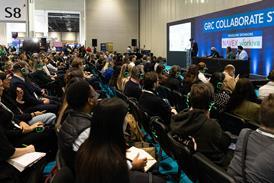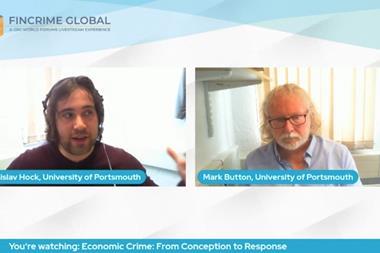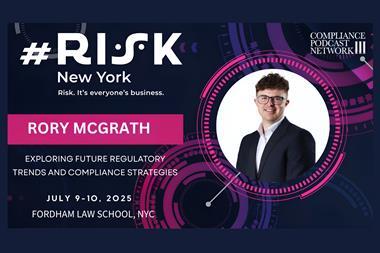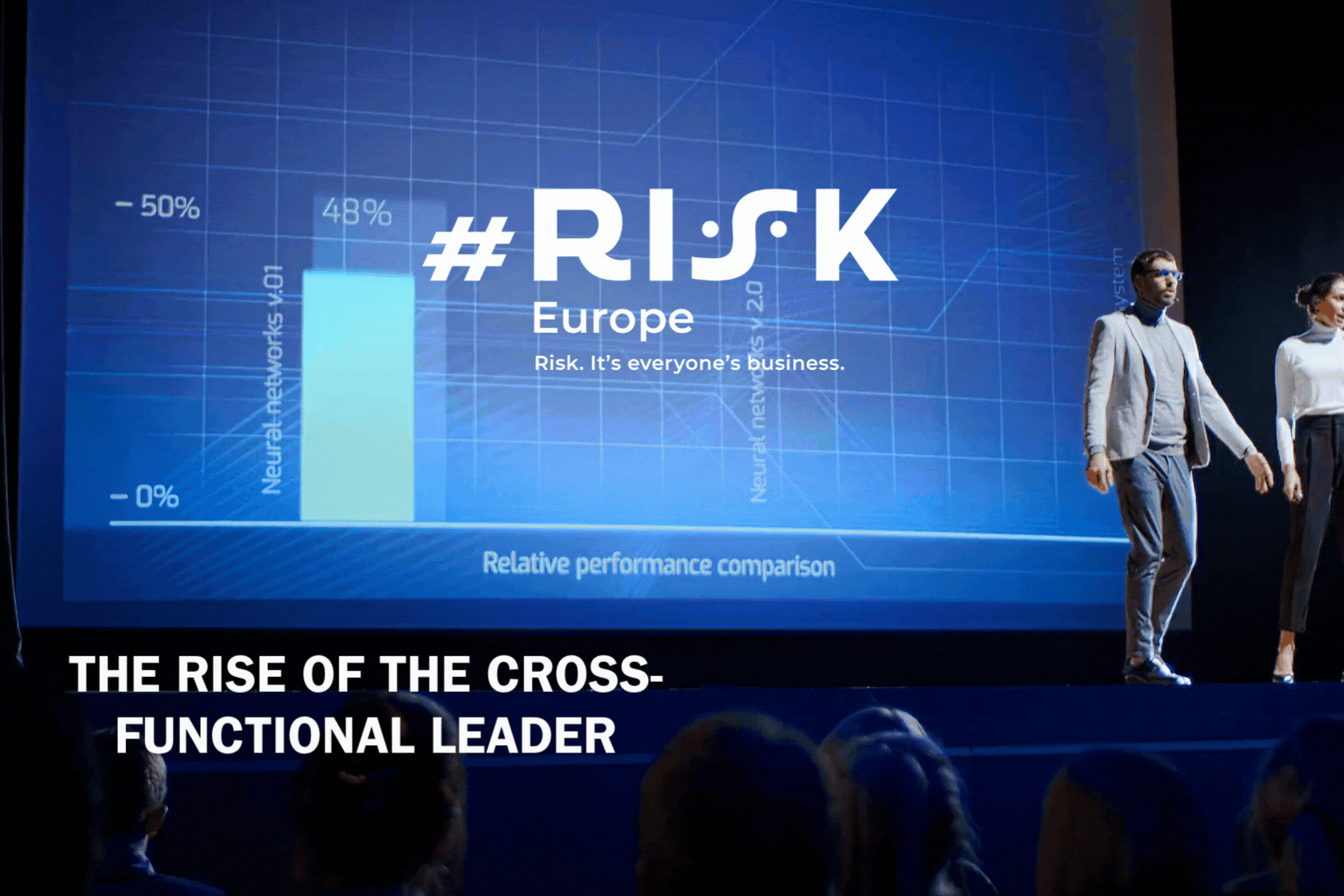Investment, it is crucial to assess their potential role within a portfolio – such as diversification benefits and return enhancement – versus the risks, which include volatility, liquidity, and regulation, among others.
Transcription
Leigh-Anne Moore:
Rob, you’re on mute.
Robert Bateman:
Apologies, I was on mute there I’m told. Good day. On behalf of GRC World Forums, the organizers of this event, it gives me enormous pleasure to welcome you all to FinCrime Global day two. My name’s Robert Bateman. I’m the head of content here at GRC World Forums, and I’ll be your host for today’s event.
Robert Bateman:
So today we’ll be bringing you a range of topical discussions and different live sessions carefully curated subject matter experts to speak on all aspects of financial crime. We’ll be looking at issues from across the world of fincrime from anti-money laundering to sanctions and the growth of crypto fraud. Make sure you view the agenda and register for sessions via the left hand side menu on the platform.
Robert Bateman:
You could also view our sponsors pages to learn more about them and view the resources that we have available for you. Before we get started, I just want to let you know about a few other events organized by GRC World Forums across the rest of the year. On the seventh and eighth of June in London and on the 28th and 29th of June in Dublin, FinCrime World Forum will feature as part of our Digital Trust Europe Series.
Robert Bateman:
This is a series of in-person events, focusing on financial crime and other important topics like data protection, ESG and cloud modernization. And at the ExCeL in London on this 16th and 17th of November this year, we’re running an exhibition called #RISK. This will feature a finance theater dedicated to bringing together the top speakers in this space.
Robert Bateman:
I’d also like to thank our sponsors, Blackdot, TruNarrative, and BioCatch for supporting our event today. So you can find more information on all of those upcoming events and our sponsors on the platform that you are using to watch this event.
Robert Bateman:
So let’s get onto our first session of the day, getting ahead and staying ahead of crypto regulations in 2022. Without further ado, let me hand over to our host for this session, Leigh-Anne Moore, who is a regulatory compliance consultant. Over to you, Leigh-Anne.
Leigh-Anne Moore:
Thank you very much, Rob. Thank you for that introduction. And good morning and welcome everyone. It’s a pleasure to be here today hosting the first session of day two. This session is titled, getting ahead and staying ahead of crypto regulations in 2022. And I’m delighted to introduce an expert panel this morning. We have Nathan and Katie joining us. Hi Nathan.
Nathan Catanai:
Hi, morning?
Leigh-Anne Moore:
Hi Katie.
Katie Fry-Paul:
Hi.
Leigh-Anne Moore:
Let’s start with a couple of introductions. Nathan, would you like to kick off?
Nathan Catanai:
Happy to. Thanks for having me here today. I’m Nathan, I’m one of the partners at XReg Consulting. The reason we called XReg is because we were founded by a team of ex regulators, and interestingly we all started or we all worked at the Gibraltar Financial Services Commission. Gibraltar’s one of the jurisdictions that’s developed a comprehensive crypto asset regulatory framework.
Nathan Catanai:
We spoke crypto asset regulation framework. Together we started XReg Consulting and we specialize in crypto regulation working both with the public and private sector. So on the public sector, we work with some governments, regulatory authorities, law enforcement, FIUs, and on the private sector we work with a lot of the big crypto assets players in the industry, as well as other businesses that have exposure to crypto assets as well.
Leigh-Anne Moore:
Great. Thank you very much. Katie.
Katie Fry-Paul:
Thanks Leigh-Anne. I’m an associate in the financial services regulatory group at Taylor Wessing in the UK, I’m also a member of the firm’s blockchain and crypto assets working group. Taylor Wessing is an international law firm with offices in 17 jurisdictions and we advise really a wide range of clients across the world.
Katie Fry-Paul:
My personal practice, I advise both fintechs and also traditional financial services firms on a broad range of EU and domestic financial services regulations. My particular experience is advising on financial services regulatory issues which arise when dealing with crypto assets and how best to handle potential challenges from the regulator.
Katie Fry-Paul:
So my clients include crypto asset exchanges, decentralized finance protocol developers, token issuers, payment service providers, and a whole host of different businesses. Really happy to be here today.
Leigh-Anne Moore:
Thank you so much. And it’s great that we’ve got such an expert panel to kick off our session this morning. And just before we get started, I would like to encourage all of our audience to please raise questions using the chat facility.
Leigh-Anne Moore:
So this is such an evolving area at the moment. Before we get into the details, Nathan, do you want to set the scene here? So how has the sort of crypto landscape evolved over the last couple of years?
Nathan Catanai:
Yes. I think if you think about how I guess most industries have developed over years, innovation usually leads in terms of regulation and policy development and crypto is no exception. So going back a few years when we saw the birth of the crypto industry, it was completely unregulated.
Nathan Catanai:
Most businesses that were interacting with crypto operating services related to crypto had I guess, to then maybe the benefit of not having any regulatory oversight, but as we know not having any regulatory oversight could lead to harm to consumers.
Nathan Catanai:
So what we had was we had businesses springing up which could be set up almost completely anonymously just with a website, these businesses in most cases and I know there’s some more innovative examples of crypto businesses, which don’t have a custody nature, but most large crypto players they actually take custody of the crypto assets of customers.
Nathan Catanai:
So what we had was we had these large custodians quasi banks and exchanges being set up with zero to no regulatory oversight. It allowed for innovation, but at the same time there were many issues. So a lot of large hacks, a lot of criminals abusing these unregulated exchanges.
Nathan Catanai:
So I guess we had that for a couple of years. And eventually what happens is that once the industry gets to a certain size, when the risks are large enough, it draws attention of governments, regulators, policy makers.
Nathan Catanai:
And we had this, what for me was probably one of the key changes in crypto asset industry from a regulatory perspective is that the financial action task force, they set a new standard and effectively they mandated and they defined crypto asset activities, and they defined crypto asset so what they call virtual assets.
Nathan Catanai:
So the FAFT defined virtual assets, and they define businesses dealing with virtual assets, which they call virtual asset service providers. And they mandated that jurisdictions to comply with FAFT standard need to bring in appropriate AML/CFT focus regulation for crypto assets.
Nathan Catanai:
So as from that day, which for me again was probably one of the key defining moments in crypto asset regulation governments need to, and I say need in a light sense, I guess, because they asked for recommendations, but as we know, not complying with FAFT recommendations comes with some serious consequences. So as from then countries have been bringing in crypto asset regulation, at least focused on AML/CFT.
Nathan Catanai:
Certain jurisdictions already had crypto asset regulation in place prior to these path of changes. But this really set the bar for crypto asset regulation and as from then countries have been bringing in appropriate frameworks to regulate crypto assets from an AML/CFT perspective that can come in many shapes and forms.
Nathan Catanai:
So in some jurisdictions, you need to apply for a full financial service license. Other jurisdictions, such as the UK, you need to register purely for AML/CFT purposes with a regulator or central bank in other jurisdictions. But I guess that’s where the industry has gone to, or that’s where we are today.
Nathan Catanai:
We’re in a position where I guess the majority of countries have been catching up and implementing these changes and regulating crypto for AML/CFT purposes. We’re still not there in terms of global harmonization, but I would argue that we don’t really have global harmonization of most regulation anyway.
Nathan Catanai:
So that’s probably a bit of a dream, but I guess that’s where we are today. So we’ve got the majority of countries having brought in AML/CFT frameworks with a few lagging behind.
Leigh-Anne Moore:
Thank you, Nathan. That’s was such a excellent synopsis of where we are today. Katie, if I turn to you. So one of the points that Nathan’s mentioned is that jurisdictions are at different stages. Could you maybe provide some detail around where we are in the UK? What stage are we at in the UK?
Katie Fry-Paul:
Yeah. Sure. And I think it’s what Nathan was saying about where different jurisdictions are, every jurisdiction is on a scale. So there are jurisdictions which have implemented a bespoke regime for crypto assets regulation and then there are jurisdictions which have said any transactions involving crypto assets are prohibited, and then there’s kind of everything in between that.
Katie Fry-Paul:
The situation in the UK is that we don’t have a bespoke regulatory regime for crypto assets. So essentially we have to deal with what we have. And what we have is UK securities law. So we would look at a token and analyze exactly what it is and whether it could be considered a traditional financial instrument like a share in a company or a unit in a collective investment scheme.
Katie Fry-Paul:
So that’s kind of the starting point. Is it something that we already know about and already is regulated? And if so we treat it in the same way as the traditional actual instruments, which is regulated. We also need to look at payment services regulation, and also the electronic money regulation to see if the token fits within those regimes. And I’m sure we’ll talk about how that’s going to be expanded to cover some crypto assets later in the session.
Katie Fry-Paul:
And then as Nathan was saying, the kind of key part of this really is the AML and CTF. So the UK has implemented the financial action task force recommendations, or the majority of them at this stage in the money laundering regulations. So that’s really applied to certain crypto asset firms, which are operating in the UK.
Katie Fry-Paul:
And the way that the UK has implemented those recommendations is quite broadly, certainly more broad than other jurisdictions. So for example, in the UK’s view, a crypto asset exchange provider is a very broad definition, which could include a lot of different firms that you might not expect to be within that category.
Katie Fry-Paul:
So it includes any firm which is arranging for the exchange or making arrangements with the view to the exchange of crypto for fiat and vice versa or crypto for crypto. And that’s broader than FATF recommendations and broader than a lot of other jurisdictions. So that’s kind of the situation at the moment in the UK.
Leigh-Anne Moore:
That’s great. Thank you very much. And just picking up on some of the points that you’ve raised there around trying to sort of fit crypto to existing regulations, I guess, is that the correct approach or is that the right approach that should be taken or do you think it’s crypto has nuances and different sort of risk profiles and should have its own sort of framework? What are your thoughts on that?
Nathan Catanai:
I tend to agree with that. Although I think maybe playing devil’s advocate if you think about the majority of crypto asset businesses that have been successful to date, they very much operate centralized models. So like I said, they act very similarly to other financial services businesses. The only thing is that they weren’t regulated because they were dealing with crypto.
Nathan Catanai:
So it was a bit of a, almost like a copower, I guess you had these businesses doing very similar activities to other financial services businesses, keeping custody of millions and even billions of custom assets, acting as this sort of centralized custodian with centralized weaknesses and touch points, providing services in a very similar way to other financial services businesses.
Nathan Catanai:
For those businesses I would argue that the more traditional forms of financial services regulation applies to a large extent, AML/CFT regulation as well. I mean, they clearly have identifiable customers that they’re onboarding. They’ve got transactions running through their exchange platforms. You have the ability to do everything that’s in the traditional AML/CFT principles.
Nathan Catanai:
But when you start looking at the more innovative models, some of the more emerging models, some of the models that truly embrace the nature of crypto assets and the key properties of crypto assets, that’s where it becomes very challenging.
Nathan Catanai:
So I’m thinking decentralized finance models in particular, where you have the ability to almost create peer-to-peer platforms that function almost on autopilot. It’s very difficult to identify a centralized operator. It’s very difficult to impose the traditional types of regulatory approaches to these models.
Nathan Catanai:
And if you do your risk really hindering the innovation that’s taking place in this space and you risk pushing the industry towards being centralized and just being similar to the other models that we’ve seen in the past and that we’re used to.
Nathan Catanai:
And you also risk potentially creating this tool to your system where we have the very, very centralized, regulated crypto models and businesses operating and then the real decentralized anonymous crypto happening outside the traditional regulatory perimeter, which probably isn’t what policy makers would want.
Nathan Catanai:
Because I would argue that it would be better to have some more appropriate, innovative, bespoke regulation to address the risks with these type of decentralized models, to protect consumers in a different way, a better way than force everything to be completely unregulated and anonymous and then you have zero oversight control over these models.
→ SEE ALSO: FinCrime World Forum
Part of the Digital Trust Europe Series - will take place through May, June & July 2022, visiting five major cities;
Brussels | Stockholm | London | Dublin | Amsterdam
Get to the edge of the financial crime debate at FinCrime World Forum.
Leigh-Anne Moore:
Yeah. Absolutely. And within this sort of crypto regulation space, I mean, there seems to be a lot of collaboration going on that seems to be a slightly different approach that’s being taken industry wide. What are your thoughts on that.
Katie Fry-Paul:
On collaboration between crypto firms you mean, on the-
Leigh-Anne Moore:
Yeah. I think in general collaboration across the industry with firms, with other regulators.
Katie Fry-Paul:
Yeah. I think that’s right. And I see a lot of firms who are engaged in the process of building regulation. And I kind of agree that there should be a nuanced bespoke regime for crypto assets because I think that, that supports both innovation and also consumer protection in a way that the current situation possibly doesn’t.
Katie Fry-Paul:
And the industry has to be involved in building that because the industry knows where these firms are going, it knows what’s going to come up the line next. There’s no point enacting rules and regulations which will be out of date in a month’s time. It doesn’t help anyone and it doesn’t provide clarity and it doesn’t allow the regulators to protect consumers.
Katie Fry-Paul:
So there has to be this kind of back and forth between industry and regulators. And I think it’s really interesting that on this week, Monday or Tuesday, it was announced that in the UK, the Financial Conduct Authority is going to be running a crypto sprint in May.
Katie Fry-Paul:
And the kind of the reason for that crypto sprint is to develop these regulations and say that the regulator can allow firms to innovate in a safe space, and then also use the data from that sandbox to develop their regulations. And I think we’ll see increasing collaboration between regulator and also firms in the space.
Leigh-Anne Moore:
Thank you. So we’ve seen and we’ve talked about a lot of the focus on AML and CTF. What are the other sort of emerging areas of regulation that we’re likely to see within this space?
Nathan Catanai:
I’d probably have to say consumer protection is the next thing on the horizon. So I think once AML/CFT is handled or sorted as much as it can be, I guess regulator will turn to the next emerging risk. And if you look at the crypto asset industry as a whole, if you look at the way some of these businesses have marketed in the past to customers, the type of customers that could potentially be coerced or abused, that’s where I think regulators are going to turn their attention to.
Nathan Catanai:
And we’ve already seen it in jurisdictions. We actually saw a flurry of announcements in the same week where the UK, Spain and Singapore all announced different changes to consumer protection regulations with regards to crypto. So which almost seemed coordinated given how close they were together, but I’m sure it wasn’t.
Nathan Catanai:
But yeah. So that was very interesting. So I think the way crypto firms will be able to market themselves to consumers, disclosure requirements will be particularly important as well, even going to the extent of crypto asset businesses, assessing the sort of suitability and appropriateness of their products without using miffed terms, but I think that’s where it could be heading.
Nathan Catanai:
They really need to take a step back think about their consumers, consider whether what they’re offering to their consumers is appropriate. Even look to the background of your customers, the financial background especially. So for me that’s, I think probably the short to medium term, that’s where we’re going to see most of the developments.
Nathan Catanai:
And I’d probably say a step further, maybe more of a medium to long term development you would probably start seeing more prudential type requirements, more requirements on custody, cyber protection, those kind of things more focused on the protection of assets. So yeah. I think probably see in financial crime protection of consumers and then protection of assets will come after that I would say, if I have to predict.
Leigh-Anne Moore:
Thank you. Katie, do you share that view? Anything else that you are seeing from your perspective in the UK?
Katie Fry-Paul:
Yeah. I think I absolutely share that view and that is completely born out in the UK as Nathan mentioned, the financial promotions regime in the UK is being extended to cover certain qualifying crypto assets and that will really impact crypto asset firms ability to promote their products in the UK, because they’ll have to, if they’re not authorized themselves, they’ll have to get an authorized firm to approve their communications.
Katie Fry-Paul:
And this is really an attempt by the government to place friction in the process of obtaining these, what they think are kind of high risk investments. Anyone who’s been in London in the past couple of years they’ve seen the adverts on the Tube for various coins with cartoon animals on them.
Katie Fry-Paul:
And I think we’re really seeing a step change in that just won’t be possible anymore because there’s going to be really kind of strict rules about how you can promote these things. And I think that’s a good thing. And I think that gives the regulator a way to protect consumers. I think also speaking about kind of bringing other crypto assets into the regulated sphere.
Katie Fry-Paul:
Of course, this week, we’ve seen the announcement in the UK, that stablecoins that are used as a means of payment will be brought within the regulatory perimeter. And it was kind of trumpeted as a real boom for the UK in terms of supporting innovation and allowing regulated payments using stablecoins and we’ll see how that play is out.
Katie Fry-Paul:
But I think it’s definitely a really exciting time I think for crypto asset firms, really all of this regulation, I think it can seem that there is almost too much of it and it’s kind of stifling innovation, but actually I think it really supports it because it means that crypto asset businesses gain legitimacy and can be kind of brought into the mainstream and really grow and have effective competition. And I think that’s going to be good for the industry.
Leigh-Anne Moore:
Absolutely. Nathan do share that view?
Nathan Catanai:
Yeah. I definitely. And I agree with Katie in the sense that I think other than looking at different regulatory risks that need to be addressed looking at like I said, consumer protection and prudential custody requirements, it is interesting to see what approaches will be taken to the more innovative models.
Nathan Catanai:
So as Katie said, I think stablecoins is also one of the emerging areas that’s coming under a lot of regulatory attention. DeFi is another one. NFTs, maybe focusing on DeFi, if you look at the actual, the content in the FCA crypto sprint. One of the key sort of web streams of questions they want to address is regulation on the more decentralized models.
Nathan Catanai:
So definitely policy makers and regulators are thinking about these things. Even the FAFT of guidance, which they updated touches on DAPs and the more decentralized model and it really questions, when does regulation start and end? So when do you have centralized player that can be subject to regulation and when is it so decentralized that there’s effectively nothing to, or nobody to regulate.
Nathan Catanai:
Also, bring in these sort of questions about having whether entities have sufficient influence or significant influence or control over certain elements. And I think it’s really going to challenge certain sort of legal tests when it comes to regulatory scope and perimeter further down the line as well.
Leigh-Anne Moore:
Yeah, certainly. That’s great. Thank you both so much. We’ve had quite a few questions coming in, so I want to make sure that we’ve got sufficient time to go through some of these. So let me ask a couple of these questions.
Leigh-Anne Moore:
So one of the questions that we’ve had come in is, what are your thoughts on the differences, or even the relationship between crypto and central bank digital currencies in terms of the regulatory elements? Who wants to lead on that one?
Nathan Catanai:
Happy to. So I’ll go if you’d like.
Leigh-Anne Moore:
Go ahead, Nathan.
Nathan Catanai:
Yeah. I think CBDC it’s an interesting one because there’s, I mean, many countries are working on their own CBDCs, but it hasn’t been a retail CBDC that’s fully live yet. So it would be interesting to see how certain countries roll out their CBDC is what sort of privacy features are present in certain CBDC, how countries manage that.
Nathan Catanai:
You could have certain CBDCs which are not retail and you’d sort of have an intrabank CBDC settlement system, but retail customer… not. But let’s assume we have a pure CBDC which could be used by consumers, which effectively will work almost like a crypto asset. You would have a BRICK coin in your wallet.
Nathan Catanai:
You can have 100 pounds stored on your phone, and it would function as 100 pounds stored physically in your own wallet. It could function very similarly to a crypto asset. So in terms of controls in place, you would probably see at least from a financial crime perspective similar controls that banks use with physical cash.
Nathan Catanai:
So there’d probably be quite an enhanced risk of consumers having a large amount of CBDCs held in their own wallets. You’d probably look at a lot of enhanced due diligence with customers depositing large amounts of CBDC. So I guess it would function very similarly to crypto assets, but again, it very much depends on how these CBDC actually implemented in practice.
Nathan Catanai:
So I guess it’s a bit of a wait and see, but if you want to predict how these things are going, think about the controls and regulation that’s applying to crypto and think about the risks that you can see with crypto assets as well.
Leigh-Anne Moore:
Thank you. Katie, I can see you are nodding your head in agreement.
Katie Fry-Paul:
Yeah. Absolutely in agreement. I think CBDCs are really interesting. And I think, especially in terms of looking at how different jurisdictions are thinking about implementing them. So whether they’re used on a wholesale basis or whether there is going to be a retail CBDC, or whether there’s a mixture of the two and kind of how they’re designed in terms of use of the private sector.
Katie Fry-Paul:
So for example, in the UK we know that if a CBDC is issued in the UK, then it’s likely to be via a user interface, which is provided by private companies and how that all works in terms of the different levels and security around it. I think it’s a really interesting area and I think it’s going to probably revolutionize payments.
Leigh-Anne Moore:
Thank you. There’s been a couple of questions which touched on a similar topic. So with respect to regulators, what are certification requirements for those providing crypto services and who sets the standards for those?
Nathan Catanai:
Do you want to take that Katie?
Katie Fry-Paul:
Yeah. I think this is maybe talking about the registration requirements and what you need to become registered. And I think in the UK-
Leigh-Anne Moore:
Is it a registration or is it a sort of licensing? I sometimes get confused as to which it is.
Katie Fry-Paul:
Yeah. So at the moment if we’re talking about just the, kind of the money laundering regulation requirements, if we say that the crypto asset business isn’t dealing in something, which is a traditional financial instruments, and the money laundering regulations apply, then it’s a registration requirement.
Katie Fry-Paul:
But actually in the UK, the process for registration is very, very similar to the process with full authorization. And I would say that potentially the detail that the Financial Conduct Authority will expect the firm to go into in the application for registration is very, very similar to that for authorization.
Katie Fry-Paul:
So we’re whereas further other registrations under the money laundering regulations is a registration, it is a we are going to do this, please register us. Maybe a little more than that, I’m exaggerating. But it is a detailed application to the Financial Conduct Authority.
Katie Fry-Paul:
And it is a detailed process and the Financial Conduct Authority look in great detail at the application materials, at the policies and procedures that the firm has in place, and also at the structure and the personnel that the firm has in place.
Katie Fry-Paul:
The money laundering reporting officer is key and will be expected to be an experienced individual. Firms looking to register in the UK need to really be swept up with their regulatory obligations in that regard.
Leigh-Anne Moore:
Thank you.
Nathan Catanai:
I agree. Maybe just in terms of standard setting, I think it’s quite important to distinguish between who sets law and regulation and then the function of a regulator. Because I think that gets quite muddled up. I mean, policy and law set by government, by policy makers and it’s up to the regulator really to interpret the law and to assess compliance against the laws.
Nathan Catanai:
So it is quite a separate function. So with regards to crypto government will set their policy, will set laws and regulations, and then regulators will need to enforce it. And I think using the FCA, as an example, the crypto assets were brought into the AML framework of the UK. The FCA was designated as the competent authority responsible for overseeing that.
Nathan Catanai:
And then the FCA will come up with the standards in terms of the application form and have their own internal judgment and standards in terms of what expectations they have, how certain companies might need to implement things like blockchain analytics.
Nathan Catanai:
A lot of that stuff won’t be in the law, but the regulator will have an idea of what they expect and what they expect to see for these companies to comply with the law. So even though AML law for example, an AML standards are very, I wouldn’t say I harmonized, but quite similar from jurisdiction to jurisdiction, the way regulators view these things, the way they approach it, their risk appetite towards certain businesses, it can vary quite significantly as well.
Nathan Catanai:
So it’s very much a case of take a look at the law, take a look at the standards and the guidance being set by the regulator, but sometimes it’s also a case of having exposure to particular regulators and trying to really get into their minds and understand what they’re looking for as well.
Leigh-Anne Moore:
That’s great. Thank you. Katie, we’ve had another question come in. Are there any ISO kind of standards within this space?
Katie Fry-Paul:
I mean, this is really not my area and Nathan may be better placed to answer, but I am aware that there are a number of cryptocurrencies which meet certain ISO standards and can therefore be used by banks. Nathan, if you have, there’s not kind of one standard that crypto assets have to meet as-
Nathan Catanai:
Yeah, I’d agree. I think too, again, not my area of expertise to be honest when it comes to ISO standards, but ISO standards can be applied by different businesses. And I know there are certain crypto businesses that do obtain certain ISO certifications when it comes to cyber and those kind of things.
Nathan Catanai:
There are a few sort of standards setting initiatives that we’ve seen. So one of them we were actually quite in involved in it’s it was called the IVMS 101 standard. And this is a data standard for the provision of travel rule information.
Nathan Catanai:
So few of the big blockchain industries and ourselves is actually we convinced I think over 100 experts at the time to standardize the data that will be shared when communicating information under the travel rule. So as you know the travel rule requires crypto businesses to communicate certain information to each other beneficiary and originator information.
Nathan Catanai:
Most of them are using providers. So there’s a number of providers that allow for this exchange of information, and if they’re not speaking the same language, it can be very, very messy.
Nathan Catanai:
So the industry came together a few months ago and there is a standard which basically it’s kind of the language that needs to be communicated between these companies. So everyone is communicating and transmitting the same information. Very simple things like the date formats, are you using UK format or U.S. formats?
Nathan Catanai:
Are you going for last name or first name first, those kind of things just to make sure the data is standardized so that when this is communicated by travel rule providers, they can interact with each other and you can have different providers exchanging information between each other. So that’s one key standard that was developed quite some time ago.
Leigh-Anne Moore:
That’s great. Thank you.
Nathan Catanai:
We probably have a few other big standard initiatives that need to be set, especially because again, I think we look at crypto and blockchain there’s a need for interoperability of certain solutions and blockchains and I think we’d probably see some standard setting there as well.
Leigh-Anne Moore:
So certainly an area to watch, an emerging area. On the point of collaboration, one of the questions that we’ve had from our audience is, is there any kind of sort of global organization looking ahead developing crypto regulations in connection with research, both from a sort of science and a technology perspective, are you aware of any organizations like that?
Katie Fry-Paul:
So I think the big one here is one that we’ve already spoken about and that’s the Financial Action Task Force, which we’ve spoken about in the context of obviously the anti-money laundering and counter terrorist financing. There are also other organizations which are very active in the space.
Katie Fry-Paul:
So there’s the, and I’ll try and recall what the initial stands for the IOSCO, which is the International Organization Securities Commission. And there’s an extra O there. And that’s really a group of, as the name suggests, international securities regulators who come together to develop standards and to set really high level principles for regulation.
Katie Fry-Paul:
And I think as we discussed earlier, it is really key. And Richard Fox of the FCA this week mentioned this in his speech talking about how important it is for high level standards to be set on an international level and then for individual jurisdictions to be able to implement rules and regulations to get to those standard.
Nathan Catanai:
Yeah. I’d agree with Katie. I think you’ve got to look at the work of the international bodies, particular policy making bodies, just to take a look at where things are going. And I think using IOSCO as an example, I think only last week they released a report on risks for DeFi.
Nathan Catanai:
So they are quite actively involved in looking out there and looking at the risks posed by crypto. But again, it’s usually up to the jurisdiction to implement these standards. So even though we will have some sort of high level overarching goal when it comes to policy, it very much depends on how jurisdictions implement this kind of stuff.
Nathan Catanai:
And it happens with the broader financial services world as well. So I don’t think we can expect pure harmonization as wonderful as that would be, to be honest.
Katie Fry-Paul:
I do think it is useful to note that actually in financial services is probably one of the most collaborative regulatory spaces internationally. I think it is kind of broadly accepted that, that is of benefit to everyone, even though there are as we say, these jurisdictional differences.
Nathan Catanai:
Yeah. And I think we talked about this sort of collaboration in the industry. And I think the crypto industry is still in its infancy and you do have this sort of collaborative atmosphere in the industry.
Nathan Catanai:
You do have even competitors in this space coming together and working on working groups together and participating in industry bodies, because I think we’re looking for the same thing, which is a very safe environment for crypto tool to thrive in.
Leigh-Anne Moore:
That’s great. I’m just having quick look. We’ve got some really interesting questions coming in all the time at the moment. Let’s tackle a few of those. There’s an interesting question.
Leigh-Anne Moore:
DeFi has grown from failure of centralized financing and a loss of privacy and security, account seizures and U.S. treasury proposing $600 transaction backing. So the question that’s been raised is what’s wrong with the blockchain zero trust model?
Nathan Catanai:
That’s an interesting one. And I think-
Leigh-Anne Moore:
It is
Nathan Catanai:
I for one would probably argue that I’m a bit of a crypto maximalist and I embrace crypto and I’m really interested in DeFi and NFTs and all the way the wonderful stuff that you can do with crypto. But I think when you look at DeFi having a pure DeFi, or an example of pure DeFi in my view, maybe again, acting as devil’s advocate and maybe with my X regulator hat on it’s you and far between.
Nathan Catanai:
Most DeFi protocols do have a very centralized group of people either running them, or marketing them, or having control of signature of private keys. There are very few pure decentralized platforms that exist out there today. And that’s where these risks emerge.
Nathan Catanai:
And you have seen a lot of examples with DeFi protocols being abused, either folorical exploits or people getting access to liquidity pools or private keys or even being able to change certain elements of smart contracts. And here’s where I think the regulators would argue that a lot of DeFi is not really DeFi and a lot of this activity needs to be regulated.
Nathan Catanai:
So I think that would be an argument against DeFi right now. We never know. I think we would see some more pured examples of DeFi emerge. At the same time again, maybe thinking as an ex-regulator, we would want to see certain protections being embedded in DeFi as well. So having this pure peer to peer system, which allows for anonymity and abuse by bad actors, I don’t think will last long term.
Nathan Catanai:
And then I think here’s where we need to go back to the conversation we had earlier, which is we should probably as an industry, as policy makers, think of a way of mitigating risks and harms from DeFi, but in a way that doesn’t force DeFi to be the same as the rest of the financial services centralized industry because that would be taking a step back and not really embracing the nature of crypto.
Leigh-Anne Moore:
Thank you for sharing those insights. There’s quite a few sort of questions that have come in. Katie, do any of those sort of jump out at you? Do you want to address, I think we’ve talked about the differences in the regulations, particularly UK and U.S.
Katie Fry-Paul:
Yeah. I mean, there’s a question about crypto mining, which I think is quite interesting. So asking about whilst it’s legal in most cases, what regulations if any do you foresee in the coming years?
Katie Fry-Paul:
And I think this is really interesting because of the kind of the rise in environmental and social and governance issues and requirements and also the European Union’s kind of their MiCA regulation, will they, won’t they ban Bitcoin because of the mining aspect.
Katie Fry-Paul:
So I think this is really interesting. I think we can certainly see some developments in this area because it is so important to think about the environmental considerations that go along with crypto assets and their production.
Nathan Catanai:
Yeah. I agree. And maybe if not legal regulatory changes, I think we’re definitely going to see more standards being set as well in cleaner crypto assets as a kind of initiatives as well.
Katie Fry-Paul:
Yeah.
Leigh-Anne Moore:
Definitely. Thank you both so much. We’re coming to the end of our session. We’ve got a minute left, so I want to quickly just come back to you and just ask you, what are the sort of key takeaways for you within this space? How should firms what tools should they use? How should they be trying to sort of keep ahead of what’s going on within this space from a regulatory perspective? Nathan, I’ll go to you first.
Nathan Catanai:
I think if I had to give one I guess tip in terms of trying to stay ahead of crypto regulation is take a look at what consultations are out there. Take a look at what initiatives are out there. For me the crypto sprint in the UK is a good one. You can kind of read between the lines in terms of what policy makers and regulators are thinking by the content of these consultations.
Nathan Catanai:
I mean, the consultation on promotions we saw in the UK came out a while back. Unless there’s a massive industry uproar the content of any future regulation is not going to be materially different to what’s in these consultations. So you can start preempting and seeing what’s on the horizon by reading into some of these consultations I would say.
Leigh-Anne Moore:
That’s great. Thank you. And Katie.
Katie Fry-Paul:
Yeah. And I think just my tip would be to really embrace it and engage with it, because it’s not avoidable. Crypto regulation is not avoidable anymore, it’s global and you are not going to be able to move to different jurisdictions to avoid it. So really embrace it and engage with all of these initiatives, which allow the industry to have a say.
Leigh-Anne Moore:
That’s great. Thank you. And I know this is a topic we could have spoken for hours on. And thank you for all of the questions that have come in today. And a very big thank you to both of you, to Nathan and Katie for a very insightful and engaging discussion this morning. Thank you both very much.
Katie Fry-Paul:
Thanks.
Nathan Catanai:
Thank you very much.
Leigh-Anne Moore:
Rob, back over to you.
Robert Bateman:
Thanks Leigh-Anne. And thanks to the panel. What a great discussion there. So many questions from the audience as well. I mean, it looks like we’re certainly headed to a more tightly regulated crypto market, but there are so many unanswered questions in this space still, between the inherently transparent, but anonymous nature of the blockchain, the environmental considerations, or these proof of work coins, how to deal with the kind of centralized ownership of much of the DeFi infrastructure.
Robert Bateman:
So much to talk about and the panel did really well there getting through a lot of difficult topics. So we’ll be back in 13 minutes for a session titled, how to solve, excuse me, how to solve a growing mules problem. This is a session sponsored by BioCatch. Thank you.
FinCrime World Forum
Part of the Digital Trust Europe Series - will take place through May, June & July 2022, visiting five major cities;
Brussels | Stockholm | London | Dublin | Amsterdam
Get to the edge of the financial crime debate at FinCrime World Forum.
FinCrime World Forum is a two-day in-person event taking place as part of the Digital Trust Europe series. The event will feature presentations and panels from thought-leaders and anti-financial crime professionals that are leading the way on how we can better, more efficiently and more effectively fight financial crime.

Getting Ahead and Staying Ahead of Crypto Regulations in 2022

Investment, it is crucial to assess their potential role within a portfolio – such as diversification benefits and return enhancement – versus the risks, which include volatility, liquidity, and regulation, among others.
 Currently
reading
Currently
reading
Getting Ahead and Staying Ahead of Crypto Regulations in 2022
- 2
- 3



























No comments yet